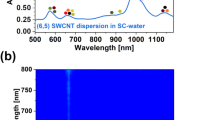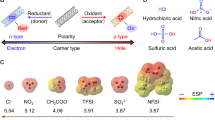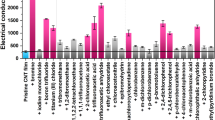Abstract
Single-walled carbon nanotubes (SWNTs) have strong potential for molecular electronics, owing to their unique structural and electronic properties. However, various outstanding issues still need to be resolved before SWNT-based devices can be made. In particular, large-scale, air-stable and controlled doping is highly desirable. Here we present a method for integrating organic molecules into SWNTs that promises to push the performance limit of these materials for molecular electronics. Reaction of SWNTs with molecules having large electron affinity and small ionization energy achieved p- and n-type doping, respectively. Optical characterization revealed that charge transfer between SWNTs and molecules starts at certain critical energies. X-ray diffraction experiments revealed that molecules are predominantly encapsulated inside SWNTs, resulting in an improved stability in air. The simplicity of the synthetic process offers a viable route for the large-scale production of SWNTs with controlled doping states.
This is a preview of subscription content, access via your institution
Access options
Subscribe to this journal
Receive 12 print issues and online access
$259.00 per year
only $21.58 per issue
Buy this article
- Purchase on Springer Link
- Instant access to full article PDF
Prices may be subject to local taxes which are calculated during checkout





Similar content being viewed by others
References
Dresselhaus, M.S., Dresselhaus, G. & Avouris, P. (eds.) Carbon Nanotubes (Spring, Berlin, 2001).
Franklin, N.R. et al. Integration of suspended carbon nanotube arrays into electronic devices and electromechanical systems. Appl. Phys. Lett. 81, 913–915 (2002).
Fuhrer, M.S., Kim, B.M., Dürkop, T. & Brintlinger, T. High-mobility nanotube transistor memory. Nano Lett. 2, 755–759 (2002).
Liang, W. et al. Fabry-Perot interference in a nanotube electron waveguide. Nature 411, 665–669 (2001).
Kong, J. et al. Quantum interference and ballistic transmission in nanotube electron wave-guides. Phys. Rev. Lett. 87, 106801 (2001).
Javey, A. et al. High-κ dielectrics for advanced carbonnanotube transistors and logic gates. Nature Mater. 1, 241–246 (2002).
Heinze, S. et al. Carbon nanotubes as schottky barrier transistors. Phys. Rev. Lett. 89, 106801 (2002).
Derycke, V., Martel, R., Appenzeller, J. & Avouris, P. Controlling doping and carrier injection in carbon nanotube transistors. Appl. Phys. Lett. 80, 2773–2774 (2002).
Kong, J. et al. Nanotube molecular wires as chemical sensors. Science 287, 622–625 (2000).
Collins, P., Bradley, K., Ishigami, M. & Zettl, A. Extreme oxygen sensitivity of electronic properties of carbon nanotubes. Science 287, 1801–1804 (2000).
Martel, R. et al. Ambipolar electrical transport in semiconducting single-wall carbon nanotubes. Phys. Rev. Lett. 87, 106801 (2001).
Zhou, C., Kong, J., Yenilmez, E. & Dai, H. Modulated chemical doping of individual carbon nanotubes. Science 290, 1552–1555 (2000).
Kazaoui, S., Minami, N., Jacquemin, R., Kataura, H. & Achiba, Y. Amphoteric doping of single-wall carbon-nanotube thin films as probed by optical absorption spectroscopy. Phys. Rev. B 60, 13339–13342 (1999).
Kazaoui, S., Minami, N., Matsuda, N., Kataura, H. & Achiba, Y. Electrochemical tuning of electronic states in single-wall carbon nanotubes studied by in situ absorption spectroscopy and ac resistance. Appl. Phys. Lett. 78, 3433–3435 (2001).
Jouguelet, E., Mathis, C. & Petit, P. Controlling the electronic properties of single-wall carbon nanotubes by chemical doping. Chem. Phys. Lett. 318, 561–564 (2000).
Kong, J. & Dai, H. Full and modulated chemical gating of individual carbon nanotubes by organic amine. J. Phys. Chem. B 105, 2890–2893 (2001).
Shim, M., Javey, A., Kam, N.W.S. & Dai, H. Polymer functionalization for air-stable n-type carbon nanotube field-effect transistors. J. Am. Chem. Soc. 123, 11512–11513 (2001).
Lee, J. et al. Bandgap modulation of carbon nanotubes by encapsulated metallofullerenes. Nature 415, 1005–1008 (2002).
Hornbaker, D.J. et al. Mapping the one-dimensional peapod structures. Science 295, 828–831 (2002).
Kataura, H. et al. Optical properties of fullerene and non-fullerene peapods. Appl. Phys. A 74, 1–6 (2002).
Shiraishi, M., Takenobu, T., Yamada, A., Ata, M. & Kataura, H. Hydrogen storage in single-walled carbon nanotube bundles and peapods. Chem. Phys. Lett. 358, 213–218 (2002).
Maniwa, Y. et al. Anomaly of x-ray diffraction profile in single-walled carbon nanotubes. Jpn J. Appl. Phys. 38, L668–L670 (1999).
Seki, N. Ionization energies of free molecules and molecular solids. Mol. Cryst. Liq. Cryst. 171, 255–270 (1989).
Smith, B.W., Monthioux, M. & Luzzi, D.E. Encapsulated C60 in carbon nanotubes. Nature 396, 323–323 (1998).
Morgan, D.A., Sloan, J. & Green, M.L.H. Direct imaging of o-carborane molecules with single walled carbon nanotubes. Chem. Comm. 20, 2442–2443 (2002).
Rao, A.M., Eklund, P.C., Bandow, S., Thess, A. & Smalley, R.E. Evidence for charge transfer in doped carbon nanotube bundles from Raman scattering. Nature 388, 257–259 (1997).
Iwasa, Y. et al. Intercalation processes of single-walled carbon nanotube ropes. New Diam. Front. C. Tec. 12, 325–330 (2002).
Kataura, H. et al. Optical properties of single-wall carbon nanotubes. Synth. Met. 103, 2555–2558 (1999).
Matsuzaki, S., Kawata, R. & Toyoda, K. Raman spectra of conducting TCNQ salt; estimation of the degree of charge transfer from vibrational frequencies. Solid State Commun. 33, 403–405 (1980).
Acknowledgements
The authors are grateful to R. Maruyama for experimental help, and to T. Hasegawa for his provision of purified organic molecules. This work has been partly supported by a grant from the MEXT, Japan (13440110 and 14750019). The synchrotron radiation experiments were performed at SPring-8, Japan, with the approval of JASRI as Nanotechnology Support Project of The MEXT. (Proposal No. 2002B0210-ND1-np/BL-No.02B2 and 2003A0323-ND1-np/BL-No.02B2)
Author information
Authors and Affiliations
Corresponding authors
Ethics declarations
Competing interests
The authors declare no competing financial interests.
Supplementary information
Supplementary Fig. S1
Supplementary Fig. S2 (PDF 162 kb)
Rights and permissions
About this article
Cite this article
Takenobu, T., Takano, T., Shiraishi, M. et al. Stable and controlled amphoteric doping by encapsulation of organic molecules inside carbon nanotubes. Nature Mater 2, 683–688 (2003). https://doi.org/10.1038/nmat976
Received:
Accepted:
Published:
Issue Date:
DOI: https://doi.org/10.1038/nmat976
This article is cited by
-
Single-wall carbon nanotube-containing cathode interfacial materials for high performance organic solar cells
Science China Chemistry (2021)
-
Thin film chemiresistive gas sensor on single-walled carbon nanotubes-functionalized with polyethylenimine (PEI) for \({\hbox {NO}}_{2}\) gas sensing
Bulletin of Materials Science (2020)
-
Controlling activation barrier by carbon nanotubes as nano-chemical reactors
Journal of Molecular Modeling (2017)
-
A computational modeling of Raman radial breathing-like mode frequencies of fullerene encapsulated inside single-walled carbon nanotubes
Journal of Molecular Modeling (2017)
-
Raman spectroscopy study of the doping effect of the encapsulated terbium halogenides on single-walled carbon nanotubes
Applied Physics A (2017)



